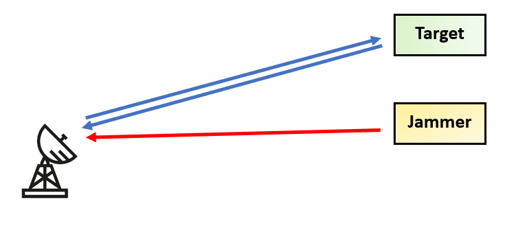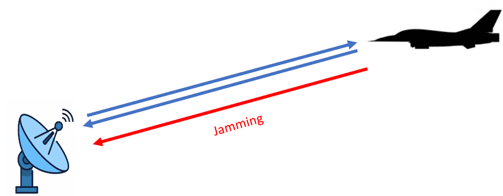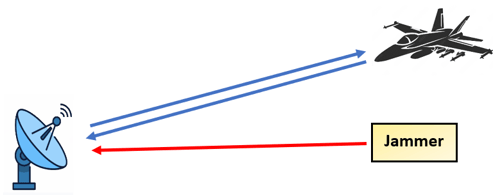Electronic attack (EA) include a set of actions aimed at diminishing the effectiveness of hostile military assets through electronic means. This dynamic approach involves targeting various enemy radars and communication systems. EA employs diverse methods, including jamming, chaff, flares, anti-radiation weapons, and high-power radiation.
Jamming as shown in Figure 1, is a key EA tactic that involves transmitting undesired signals into enemy receivers at carefully calibrated power levels and modulations. This intentional interference disrupts the receiver's ability to receive and process its desired signals, thereby degrading the enemy's access to crucial information.

Figure 1: A radar jammer transmits signals to a radar's receiver with the intention of suppress its ability to accurately receive its own reflected signal from the target.
Jamming techniques in the electronic attack domain can be categorized into two target-oriented groups. The first category which we will investigate in detail is radar jamming, which seeks to disrupt radars' ability to detect and track targets effectively.
The second type of jamming revolves around communications jamming, which focuses on hindering communication receivers from retrieving vital information from desired signals. For example, radio communications can be exposed to communications jamming.
There are two approaches to perform jamming, namely cover jamming, which aims to reduce the radar's ability to detect targets, and deceptive jamming, which introduces false range, angle, and speed returns to the radar.
Cover jamming signals are commonly modulated with noise and are applied in both radar and communication jamming scenarios. On the other hand, deceptive jamming entails transmitting signals that are intended to be received as valid signals by a hostile receiver, leading the associated radar processing circuitry to draw incorrect conclusions, such as misjudging the range or angle to a target..
We can also classify jammers based on their location. They can be categorized as "On Radar target" or "remote from the target."
On Radar target Jammer
An "On Radar target" jammer is considered a form of self-protection jamming (SPJ) that can be achieved through cover or deceptive jamming.
In SPJ, a jammer is strategically placed on an aircraft that serves as the radar's target as shown in Figure 2. The radar transmits signals to the target, and the reflection from the target, known as the skin return, is retransmitted to the radar's receiver. For pulsed radars, the skin return is typically received using the same antenna that transmitted the radar signal. On the other hand, continuous wave (CW) radars require separate transmit and receive antennas for isolation, but the radar receiver captures both the skin return and the jamming signal through the same receiving antenna.
Notably, the jamming signal's strength is amplified by the high gain of the radar antenna, significantly enhancing the jamming effectiveness. As the jammer transmits only from the target to the radar, it experiences propagation loss proportional to the square of the range from the target. In contrast, the radar signal must travel both ways (radar to target and back to radar), leading to propagation loss proportional to the fourth power of the range. Combining the receiving gain of the radar antenna and the propagation characteristics, a relatively high ratio of received jamming to received skin return signal strength (jammer-to-signal ratio or J/S) is achieved.
Due to the significant J/S ratio attainable with SPJs, they serve two essential purposes. They can either prevent an enemy radar from acquiring its target or disrupt the lock of a radar that is actively tracking the target.

Figure 2. Self protection jamming with a jammer mounted on the radar target
Remote Jamming
On the other hand, "remote jamming" shown in Figure 3, involves transmitting jamming signals from a location other than that of the target being tracked by the hostile radar.

Figure 3. Remote jamming with a jammer that transmit from another position to radar target
Remote jamming can be classified in three different types which are: Stand-off jamming, Stand-in jamming, and escort jamming.
Stand-off Jamming
Stand-off jammers are positioned at a considerable distance from both the radar and the target itself. Usually, these specialized jammers are installed on specific aircraft designed to remain outside the lethal range of weapons controlled by the radars being targeted.
Stand-in Jamming
Stand-in jammers are located in closer proximity to the radar compared to the target they aim to protect. These jammers can be strategically placed near the hostile radar or deployed on unmanned vehicles, which can be remotely controlled to optimize their jamming locations.
Escort Jamming
Escort jamming involves the transmission of jamming signals from a dedicated jamming aircraft, which operates as an integral part of a strike aircraft formation, providing protection. As shown in Figure 4 , this arrangement allows the jamming aircraft to benefit from higher jamming power typical of specialized jamming platforms. Being collocated with the protected aircraft, the jamming aircraft positions itself within the threatening radar's main beam, enabling a substantial J/S ratio.

Figure 4. In the escort role, a dedicated jammer aircraft accompanies a strike force, providing protection to the other aircraft.
Alternatively, a technique known as "Modified Escort Jamming" offers an alternate approach. In this method, the jamming aircraft is flown towards a particularly critical enemy radar to protect a critical aircraft or strike package. As shown in Figure 5, the jamming aircraft positions itself further away from the jammed radar than the protected aircraft, but still maneuvers to position itself within the main beam of the dangerous radar illuminating the protected aircraft. The jamming aircraft maintains the same speed but turns around when it reaches the limit of the lethal range of the weapons guided by the jammed radar.
Many Applications for Electronic Warfare
Follow our blogs and videos on Electronic Warfare with SkyRadar's Disturbance Filtering & Analysis solutions, the jammers and the Pulse Radar! SkyRadar is the only provider world-wide, providing manufacturer-agnostic ECM and ECCM training with simulators and real radars and jammers. Learn more about the simulator, range deception, angle deception, speed deception, radar lock on and major state of the art defense algorithms against malicious attacks.
Such defense is not only useful in a military context but also in a civil aviation setting. Increasingly speed radar jammers by trucks and cars disturb airport infrastructure. Also hybrid warfare is used to perturb critical infrastructure like airports and civil air surveillance and navigation services.




